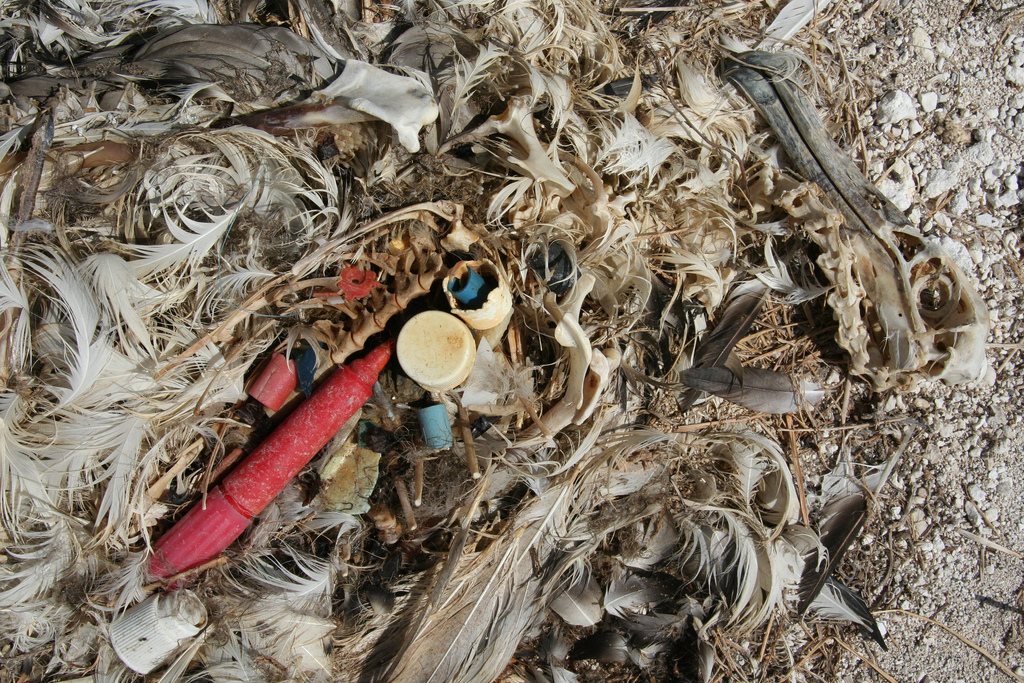
Penggunaan plastik adalah hal yang telah menjadi bagian dari budaya, fashion, dan kehidupan manusia. Selain karena memang murah, plastik dianggap lebih mudah dibuat di bandingkan harus membuat tas kain.
Namun dalam sejarah manusia, banyak penelitian yang mengungkap dampak negative dari penggunaan plastik tersebut, dari dampak kimiawi hasil dari produksi plastik tersebut, sampai dari dampak negative ketika penguraian alamiah yang terjadi di alam.
Salah satu dampak yang ditimbulkan dari kesalahan management pengolahan limbah plastik, adalah terbentuknya Pulau Sampah di lautan lepas di berbagai belahan samudra di Bumi ini, yang berdampak pada kehidupan biota laut. The Great Pacific Garbage Patch yang berada di lautan Pasific di temukan pada tahun 1988, North Atlantic Garbage Patch juga ditemukan di lautan Atlantik pada tahun 1976, dan yang paling baru adalah penemuan Indian Ocean Garbage Patch di tahun 2010. Semua Garbage Patch itu adalah pusat, pusaran dari arus samudera –samudera tersebut, dimana di saat mulai terbentuk semacam Pulau Sampah yang terdiri dari sampah-sampah baik dalam bentuk besar maupun bentuk yang lebih kecil berkumpul, membentuk semacam pulau atau bisa disebut sebagai bubur sampah di tengah lautan.
Banyak jurnalis dan advokasi lingkungan yang menyatakan bahwasanya pulau sampah yang terbentuk di Great Pacific Garbage telah sebesar benua Amerika itu sendiri, sumber lain mengatakan bahwasanya pulau itu sudah berbentuk sebesar benua Afrika, namun laopran resmi yang dibuat oleh National Oceanic and Atmospheric Administration (NOAA) menyatakan bahwasanya pulau sampah itu terbentuk seluas dua kali negara bagian Texas.
Bagaimana pulau itu bisa terbentuk? Pulau itu terbentuk dikarenakan sampah-sampah dari daratan dan lautan yang di bawa arus ke laut lepas yang akhirnya nya terbawa arus lautan menuju ke pusat aruh tersebut bertemu di samudera. Akhirnya sampah-sampah dari penjuru dunia yang terbawa arus itu terkumpul dan tertumpuk disana, menjadi sebuah pulau, atau bubur sampah lautan. Hasil penelitian menyebutkan 80-90 % dari keseluruhan sampah yang membentuk pulau sampah tersebut berasal dari sampah plastik, dan 80 % dari sampah plastik tersebut berasal dari daratan, dimana 20%nya berasal dari lautan (dari kapal-kapal yang berlayar disana), dan lautan sampah ini semakin membesar tiap tahunnya, dikarenakan jumlah penggunaan plastik yang semakin besar pula.

Pulau Sampah ini menurut penelitian memiliki dampak yang signifikan bagi biota laut yang ada di sekitar laut tersebut, seperti permasalahan dengan sampah – sampah pelastik yang sering sekali akhirnya membuat penyu, ikan,dan burung tersangkut, sehingga bisa berdampak pada kematian, lalu banyak kasus ditemukan dimana banyak burung dan ikan-ikan yang mati karena salah mengira sampah-sampah plastik dalam bentuk kecil itu adalah makanan, sehingga banyak yang mati karena keracunan, maupun mati karena tersedak. Permasalahan lainnya adalah zat kimia dari plastik itu sendiri, yang mana plastik tersebut yang terkena air garam dan sinar matahari langsung lebih cepat terurai menjadi molecular yang lebih kecil, dan plastik mengandung beberapa kandungan zat kimia yang beracun bagi dan bisa berdampak pada keracunan maupun perubahan genetis yang terjadi bagi yang tereskpose maupun mengonsumsinya, sehingga apabila ikan-ikan itu telah teracuni, maka manusia yang mengkonsumsinya juga memiliki potensi untuk mengalami keracunan karena mengkonsumsi ikan yang terkontaminasi racun.
Sehingga apa yang bisa kita lakukan? Walaupun telah dilakukan upaya untuk mendaur ulang sampah di lautan, dan membersihkan tumpukan sampah di lautan, cara tersebut masih lah sah sangat kecil effektifitasnya, dikarenakan jumlah sampahnya yang selalu bertambah dan memang berjumlah besar dalam radius yang luas pula, sehingga memang cara yang terbaik saat ini adalah dengan mengurangi jumlah pelastik yang digunakan dalam setiap kegiatan yang manusia lakukan, dengan mengunakannya berkali kali, ataupun menggunakan biodegradable bags, yang lebih ramah lingkungan, ataupun membawa tas atau kantong belanjaan sendiri sehingga bisa mengurangi jumlah penggunaan plastik , ditambah dengan cara mendaur ulamg plastik itu sendiri. Mari jadika dunia in menjadi dunia yang lebih baik dan sehat di masa depan.
Sumber:
http://www.mnn.com/earth-matters/translating-uncle-sam/stories/what-is-the-great-pacific-ocean-garbage-patch
http://www.mnn.com/earth-matters/wilderness-resources/stories/a-2nd-garbage-patch-plastic-soup-seen-in-atlantic
http://geography.about.com/od/globalproblemsandissues/a/trashislands.htm











